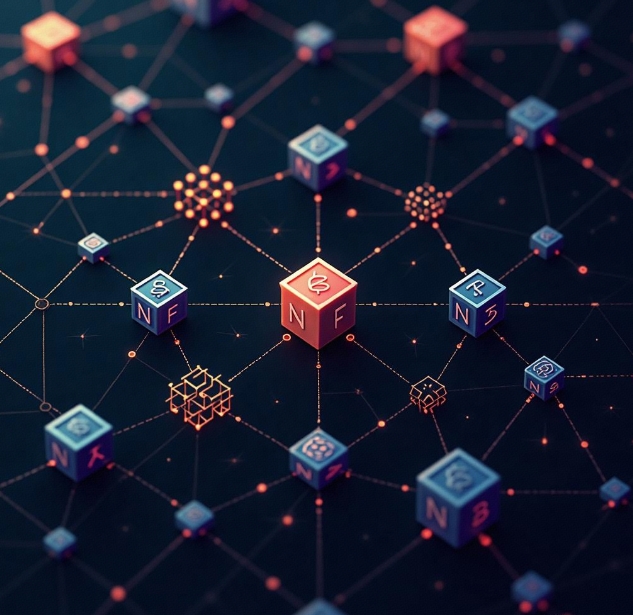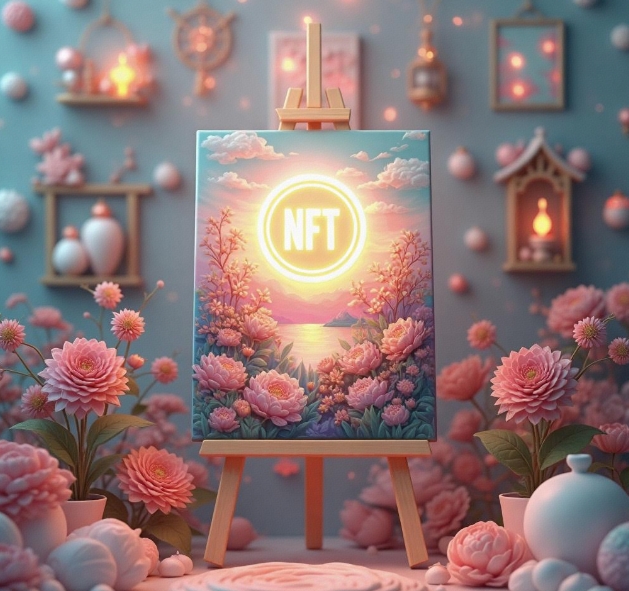NFT Development Guide: How to create and trade NFT in the Web3 ecosystem?
- latest articles
- 1.DApp Development & Customization: Merging Diverse Market Needs with User Experience 2.Analysis of the Core Technical System in DApp Project Development 3.How to achieve cross-chain interoperability in Web3 projects? 4.How does the tokenization of points reconstruct the e-commerce ecosystem? 5.How to Set and Track Data Metrics for a Points Mall? 6.What is DApp Development? Core Concepts and Technical Analysis 7.Inventory of commonly used Web3 development tools and usage tips 8.Development of a Distribution System Integrated with Social E-commerce 9.Six Key Steps for Businesses to Build a Points Mall System 10.What is DApp Development? A Comprehensive Guide from Concept to Implementation
- Popular Articles
- 1.Future Trends and Technology Predictions for APP Development in 2025 2.Analysis of the DeFi Ecosystem: How Developers Can Participate in Decentralized Finance Innovation 3.From Zero to One: How PI Mall Revolutionizes the Traditional E-commerce Model 4.DAPP Development | Best Practices for Professional Customization and Rapid Launch 5.Recommended by the Web3 developer community: the most noteworthy forums and resources 6.From Cloud Computing to Computing Power Leasing: Building a Flexible and Scalable Computing Resource Platform 7.How to Develop a Successful Douyin Mini Program: Technical Architecture and Best Practices 8.Shared Bike System APP: The Convenient Choice in the Era of Smart Travel 9.How to Create a Successful Dating App: From Needs Analysis to User Experience Design 10.From Design to Development: The Complete Process of Bringing an APP Idea to Life
With the rapid development of blockchain technology, the application of NFTs (Non-Fungible Tokens) is gradually increasing worldwide. From the digitization of artworks to the ownership of virtual items and identity verification, the application scenarios of NFTs are becoming increasingly diverse. The Web3 ecosystem, as a decentralized network architecture, endows NFTs with greater creativity and trading flexibility, making NFTs an important component of the blockchain world. So, how can you create and trade NFTs in the Web3 ecosystem? This article will provide you with a detailed NFT development guide, taking you in-depth into how to create, issue, and trade NFTs.
1. What is an NFT?
Before delving into NFT development, we need to clarify the concept of NFTs. NFT stands for Non-Fungible Token, which is a digital asset based on blockchain technology. Unlike cryptocurrencies such as Bitcoin and Ethereum, NFTs possess uniqueness, non-fungibility, and verifiability.
The uniqueness of NFTs lies in the fact that each NFT represents a unique digital or physical asset and cannot be replaced by other tokens. Therefore, NFTs are widely used in fields such as digital art, music, videos, and in-game items, with their application in the digital art field particularly becoming a trend. Through smart contracts, NFTs ensure that the ownership and transaction history of each asset are publicly transparent and recorded on the blockchain.
2. Prerequisites for Developing NFTs in the Web3 Ecosystem
Web3 is a decentralized internet built on blockchain technology, emphasizing user autonomy and data privacy. In the Web3 ecosystem, developing NFTs requires a certain technical background. Below are some prerequisites before developing NFTs.
1. Basic Blockchain Knowledge
The foundation of developing NFTs is an understanding of blockchain technology, especially how smart contracts work. Blockchain is a decentralized distributed ledger that records and verifies all data and transactions on the blockchain through smart contracts.
2. Solidity Programming Language
Solidity is the most commonly used programming language for smart contract development, primarily for building applications on the Ethereum blockchain. When developing NFTs, we typically use Solidity to write smart contracts to generate and manage NFTs on the blockchain.
3. Web3.js or Ethers.js
Web3.js and Ethers.js are JavaScript libraries used to connect Web3 applications with the blockchain. They help developers interact with blockchains like Ethereum, enabling functionalities such as wallet connection and smart contract invocation.
4. Use of Testnets and Mainnet
To avoid conducting transactions directly on the mainnet during development, developers typically use test networks (such as Rinkeby, Goerli, etc.) for smart contract deployment and NFT testing. Testnets simulate the mainnet environment but do not incur actual financial losses.
5. Wallet Support
NFT transactions and management require a crypto wallet, such as MetaMask. Wallets can not only store cryptocurrencies but also store NFTs, conduct transactions, and manage them.
3. Steps to Create an NFT
1. Choose an NFT Standard
When creating NFTs on blockchains like Ethereum, the most common standards are ERC-721 and ERC-1155.
ERC-721: This is the earliest NFT standard, where each token represents a unique asset with uniqueness and non-fungibility. ERC-721 is suitable for scenarios where batch issuance is not needed, and each asset has unique attributes.
ERC-1155: This standard supports the creation of multiple asset types, allowing both fungible tokens (like cryptocurrencies) and non-fungible tokens (like artworks) to be created within a single smart contract. ERC-1155 is more efficient and suitable for scenarios requiring batch issuance of NFTs, such as virtual items in games.
2. Write a Smart Contract
The smart contract is the core of an NFT; all logic and rules regarding the NFT are implemented in the smart contract. Below is a simple example of an ERC-721 smart contract:
// SPDX-License-Identifier: MIT
pragma solidity ^0.8.0;
import "@openzeppelin/contracts/token/ERC721/extensions/ERC721URIStorage.sol";
contract MyNFT is ERC721URIStorage {
uint256 public tokenCounter;
constructor() ERC721("MyNFT", "MNFT") {
tokenCounter = 0;
}
function createNFT(address to, string memory tokenURI) public returns (uint256) {
uint256 newItemId = tokenCounter;
_safeMint(to, newItemId);
_setTokenURI(newItemId, tokenURI);
tokenCounter = tokenCounter + 1;
return newItemId;
}
}
This contract inherits from ERC721URIStorage and includes the most basic functionalities of an NFT: creating an NFT and setting the tokenURI.tokenURI is the metadata of the NFT, typically containing links to the NFT's image or other media files.
3. Deploy the Smart Contract
After writing the smart contract, we need to deploy it to the blockchain. Use a Solidity compiler (like Remix IDE) to compile the contract and deploy it by connecting to a test network via a MetaMask wallet. Deploying a contract requires paying a certain amount of Gas fees (i.e., transaction fees on the blockchain).
4. Create the NFT
Once the smart contract is deployed, you can create NFTs using the createNFT method in the contract. When creating an NFT, you need to provide the holder's address (usually your own wallet address) and the tokenURI (i.e., the metadata link of the NFT). After creation, each NFT will have a unique ID and be recorded on the blockchain, ensuring its uniqueness and ownership.
5. List on an NFT Marketplace
Created NFTs can be displayed and traded on various NFT marketplaces. Common NFT marketplaces include OpenSea, Rarible, and SuperRare. Listing an NFT typically requires providing detailed information (such as title, description, image) and setting a price. Some marketplaces also allow auction functionalities.
4. NFT Trading Process
The process of trading NFTs is similar to traditional digital asset trading, but its decentralization and transparency make transactions more efficient and secure.
1. Create an NFT Wallet
Before engaging in NFT trading, you need a crypto wallet that supports NFTs, such as MetaMask. Wallets can not only store NFTs but also be used for transactions and management.
2. Choose a Trading Platform
Select a platform that supports NFT trading. OpenSea, Rarible, Foundation, etc., are well-known NFT trading platforms. Each platform has different trading rules and fee structures, so choosing the right marketplace for trading is crucial.
3. List and Purchase NFTs
On NFT marketplaces, users can list their own NFT works or purchase NFTs from others. When purchasing an NFT, users need to ensure they have sufficient ETH or other cryptocurrencies in their wallet.
4. Transaction and Transfer
When a user purchases an NFT, the NFT is transferred through a smart contract, and all information during the transfer process is recorded on the blockchain, including transaction time, buyer and seller addresses, transaction amount, etc. Due to the immutability of the blockchain, all transaction histories can be traced and verified.
5. Fees and Commissions
NFT transactions typically incur certain fees, including Gas fees and platform trading commissions. Gas fees are the costs for conducting transactions on the blockchain network, while platform commissions are service fees charged by the trading platform based on sales.
5. Future Development Trends of NFTs
As an important component of the Web3 ecosystem, NFTs are likely to demonstrate broader application potential in multiple fields in the future.
Digital Art and Copyright Protection: NFTs provide artists with a mechanism for copyright protection of digital works, addressing the issue of copyright ownership that exists in traditional art trading. Artists can permanently record their works on the blockchain through NFT smart contracts.
Virtual Asset Trading: NFTs will promote the integration of the virtual and real worlds, especially in games and virtual reality. NFTs can represent players' items and assets in the virtual world, allowing players to freely trade virtual items across different platforms through NFTs.
Identity Authentication and Certification: With the rise of Web3, NFTs may not be limited to art and virtual item trading but could also be widely applied in fields such as identity authentication and certificate issuance.
Environmentally Friendly NFTs: Since the minting and trading of NFTs consume energy, environmental issues are gradually becoming a focus of attention. In the future, with improvements in blockchain technology and the promotion of green environmental concepts, more energy-efficient and efficient NFT platforms may become mainstream in the market.
6. Summary
The development and trading of NFTs are core components of the Web3 ecosystem, possessing immense potential and application prospects. By understanding blockchain technology, smart contract development, and the processes of creating and trading NFTs, developers and users can better participate in this emerging digital economy.
In practical development, creating NFTs requires mastering certain technical skills. However, with the continuous development of tools and platforms, more and more people can create, trade, and manage NFTs through simple steps. Meanwhile, the future of NFTs is full of innovation and challenges. As technology advances and the market matures, NFTs will unleash unique value in more fields.
-

How to achieve cross-chain interoperability in Web3 projects?
With the continuous development of WEB3 technology, Web3 has gradually become an···
-

Inventory of commonly used Web3 development tools and usage tips
With the continuous development of blockchain technology, Web3 has become a hot ···
-

Web3 development trend prediction: analysis of future technology directions and application scenarios
With the gradual development of blockchain technology, the concept of Web3 has m···

 Blockchain
Blockchain












